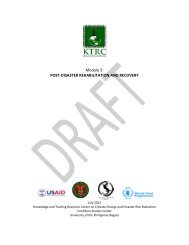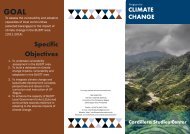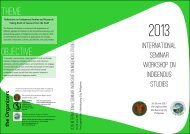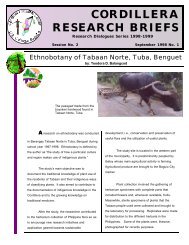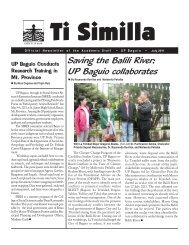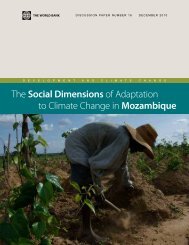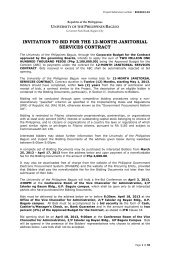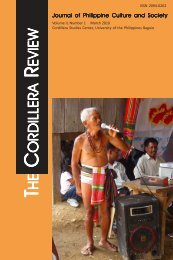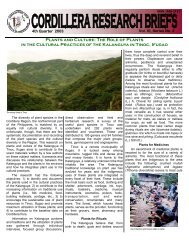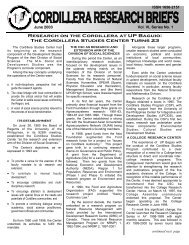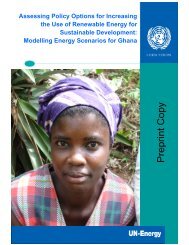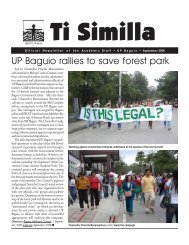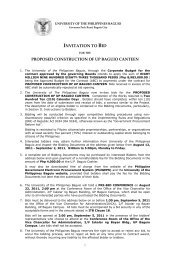Pambansang Summit sa W ambansang Summit sa W ... - UP Baguio
Pambansang Summit sa W ambansang Summit sa W ... - UP Baguio
Pambansang Summit sa W ambansang Summit sa W ... - UP Baguio
You also want an ePaper? Increase the reach of your titles
YUMPU automatically turns print PDFs into web optimized ePapers that Google loves.
Fig. 1. Annual mean TSP levels in CAR-<strong>Baguio</strong> Plaza and other EMB-<br />
DENR monitoring stations relative to the national standard, 2003-2007<br />
(In µg/m 3 )<br />
age increase of around 15% in long-term<br />
mortality risk.<br />
<strong>Baguio</strong> TSP levels<br />
Over the years, how did <strong>Baguio</strong> compare<br />
with the other cities in the Philippines<br />
in terms of air quality? The EMB-<br />
DENR National Air Quality Status Report<br />
2005-2007 showed total suspended<br />
particulates (TSP) across air quality monitoring<br />
stations in various cities in the<br />
country. Figure 1 reveals that over the<br />
years spanning 2003-2007, the CAR-<br />
<strong>Baguio</strong> station registered the highest TSP<br />
mean level (192µg/m 3 ), exceeding the national<br />
standard by a factor of 2.<br />
In recent years, the TSP measure of<br />
air quality has now been replaced by the<br />
finer particulates measure, the PM 10 , since<br />
coarser particulates could be filtered via<br />
the nose and mouth (Clean Air Initiatives<br />
for Asia, 2010).<br />
<strong>Baguio</strong> PM 10 levels<br />
Since 2007, the EMB-DENR CAR -<br />
<strong>Baguio</strong> air quality monitoring station<br />
started measuring the PM 10 levels. Table<br />
2 shows the quarterly and annual mean<br />
levels of PM 10 in <strong>Baguio</strong> from 2007 to<br />
2010.<br />
Column<br />
The quarterly entries<br />
have two quarters with<br />
missing entries. These<br />
missing entries are associated<br />
with equipment<br />
malfunction over some<br />
days within the quarter.<br />
Throughout the<br />
four-year period, the<br />
annual mean levels of<br />
PM 10 in <strong>Baguio</strong> were in<br />
violation of the national<br />
standard of 60 µg/m 3 set<br />
by the Philippines CAA<br />
of 1999. Moreover, in<br />
none of the years did the<br />
mean levels of PM 10 pass<br />
the WHO lowest interim<br />
target (IT-1) set at<br />
70µg/m 3 associated with increased longterm<br />
mortality risk by 15% relative to the<br />
AQG. Using the WHO annual mean<br />
guideline as standard, the <strong>Baguio</strong> PM 10 annual<br />
mean levels were higher by 266% to<br />
430%.<br />
On average, the PM 10 levels subside<br />
during the 3 rd Quarter. This may correspond<br />
to the rainy season and typhoon<br />
period when economic activity slows<br />
down, rainfall washes down some of the<br />
particulates, or the stronger winds blow<br />
some proportion away. Still, on a quarterly<br />
basis, there was also no period of the<br />
year where the <strong>Baguio</strong> PM 10 levels passed<br />
the national standard.<br />
On an annual basis, taking the last<br />
three years, a worsening<br />
of the PM 10 levels<br />
has been taking place.<br />
This indicates that between<br />
2008 and 2010,<br />
the air quality of<br />
<strong>Baguio</strong> had been worsening.<br />
The EMB-DENR<br />
CAR - <strong>Baguio</strong> computerized<br />
equipment<br />
records PM 10 and other ambient air pollutants<br />
at its monitoring station on real<br />
time basis. For short-term evaluations<br />
over a 24-hr period, minute-by-minute levels<br />
are captured. A <strong>sa</strong>mple period was obtained<br />
covering the days 8-11 February<br />
2011. The data are averaged on an hourly<br />
basis to obtain a picture of how the PM 10<br />
levels behave over a 24-hour period. Figure<br />
2 (next page) depicts the behavior of<br />
PM 10 levels in the <strong>Baguio</strong> Central Business<br />
District (CBD) on ordinary working days.<br />
Tracked over four days, the graph of<br />
the hourly PM 10 levels shows a strong<br />
regular pattern of peaks and troughs. The<br />
recorded levels register a mean of 67.3 µg/<br />
m 3 . This level is well within the 24-hr<br />
Philippines standard of 150µg/m 3 . Can we<br />
conclude that the air quality of <strong>Baguio</strong> is<br />
relatively acceptable? Note, however, this<br />
value is still 35% above the WHO/EU 24hr<br />
guidelines.<br />
The regular pattern of the hourly behavior<br />
of PM 10 levels in the <strong>Baguio</strong> CBD<br />
indicates that it reaches peak levels at<br />
around 06:00 and 07:00 in the morning,<br />
and another peak from 17:00 to 19:00 in<br />
the evening. Using the Philippine 24-hr<br />
150µg/m 3 guideline, the <strong>Baguio</strong> PM 10 levels<br />
regularly breach the critical value in<br />
the morning rush hour, then also breaks<br />
the 100µg/m 3 mark in the evening rush<br />
hour. Using the common WHO/EU 24hr<br />
guideline, however, citizens in the<br />
<strong>Baguio</strong> CBD are exposed daily to PM 10 levels<br />
that exceed the 50µg/m 3 critical value<br />
for almost their entire active hours, from<br />
Table 2. Quarterly and annual means of PM 10 in <strong>Baguio</strong>,<br />
2007 – 2010.<br />
April 2011 TI SIMILLA 5





